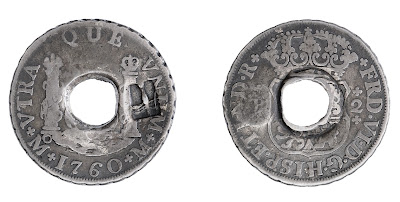A note on the Haitian law of June 17, 1811 authorizing the piercing of gourdes.
This second post in our series related to Haitian coinage covers a point which might appear not too relevant but is nevertheless much so. In many cases, a proposed theory for the attribution of obscure pieces which is entirely valid might be challenged based on small details. This is such a case: since F. C Braun's cogent article on the Haitian issues related to the June 27, 1811 law, almost everybody has accepted his proposed attribution of the holed silver coins countermarked with (what now is accepted to be) a palm tree punch, and the related extracted "plugs" as Haitian. Only a couple of debatable points remained, among which the one analyzed in our current post is probably the more relevant: in this small article, we show evidence that the holed countermarked pieces, such as the 2 Reales shown below (originally from the H. D. Gibbs collection, and now in the ANS' holdings) correspond EXACTLY and not partially to the June 27, 1811 law. Their attribution as Haitian should therefore be accepted as final.
 |
| 2 Reales pierced and countermarked with a palm tree punch in Haiti per the law of June 27, 1811. |
Our article can be accessed here:
The COAC's proceedings including F. C. Braun's article can be obtained here (a link to Charles Davis Numismatic Literature website):
A sample from Braun's article can be accessed here (but we strongly recommend to buy the COAC's proceedings):
Comments
Post a Comment